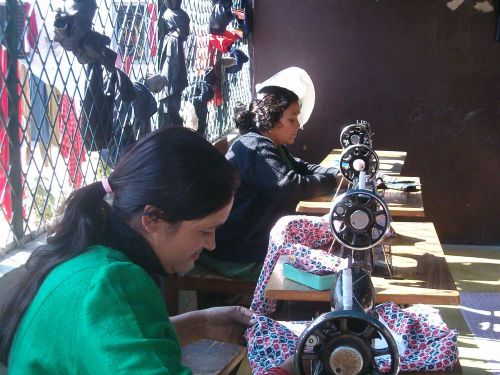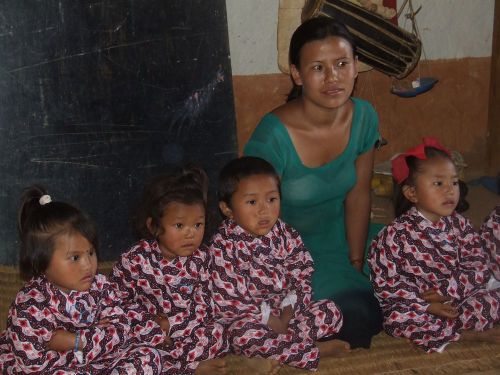 It was a very good experiences and a nice project we did in 2006-2007 in the Central Jail (Female section) in Kathmandu. We provided sewing machines to more than 40 prisoner women, technical training, management training and legal assistance. We supplied them with all materials useful to produce garments for their family and children. The second step was to tailor boto (the tradition child dress) which we distributed in the Bal Bikas (Early Childhood Dev. Centers) we created in Timal (Kavre) enrolling more than 800 children. All children got a sort of uniform which was a good help for the family.
It was a very good experiences and a nice project we did in 2006-2007 in the Central Jail (Female section) in Kathmandu. We provided sewing machines to more than 40 prisoner women, technical training, management training and legal assistance. We supplied them with all materials useful to produce garments for their family and children. The second step was to tailor boto (the tradition child dress) which we distributed in the Bal Bikas (Early Childhood Dev. Centers) we created in Timal (Kavre) enrolling more than 800 children. All children got a sort of uniform which was a good help for the family.
The last step should be to start production for the local market directed to foreign tourist wih the idea to channel garments to international fair trade market. The Women Tailor Group after one year of working and training were able to produce some nice garments from which we had selling agreements with local shops.
All was stopped by the donor (CCS Italia INGO) with no reasons in 2007. Even the brand we studied was put in a corner as well the works and hopes of the women involved.
This project was a namuna (sample) which could be extended, as our intention, to other jails in Nepal,  and we did it in coordination with Jail authorities. The objective were to assure a little income to the prisoners, give them job opportunities out of the jail and a something to do during detention in order to avoid violence and bad attitudes.
and we did it in coordination with Jail authorities. The objective were to assure a little income to the prisoners, give them job opportunities out of the jail and a something to do during detention in order to avoid violence and bad attitudes.
To create opportunities and hope (it was the brand for the Inmates Cooperative) is the only way to help prisoners during detention and to help them to be reintroduced in normal life.
A recent survey showed that the situation in Nepali jails is deteriorating form many point of view and few activities are running to help the prisoners which are detained in over crowded structures.
This research shows that 38% of the prisoners it had surveyed had access to drugs even behind the bars in different parts of the country including the Central Jail, Bhadra Bandi Griha, Bhadra Mahila Bandi Griha, Dillibazaar Jail, Nakkhu Prison, Biratnagar Prison, Pokhara Prison and Birgunj Prison
Total of 351 prisoners living in the eight jails were surveyed and 15 per cent of the respondents were women.
 Of the people who use drugs in the jails, 20 per cent said they use marijuana, 20 per cent brown sugar, 10 per cent injections and the rest 50 per cent said they use many kinds of drugs.
Of the people who use drugs in the jails, 20 per cent said they use marijuana, 20 per cent brown sugar, 10 per cent injections and the rest 50 per cent said they use many kinds of drugs.
The survey stated that 50 per cent of the Injecting Drug Users (IDUs) in the jails share same needle. Half of the IDUs in jails had visited treatment and rehabilitation centres and hospitals at least once while the another half had never gone to either a hospital or any drop-in centre.
Legal assistance, income generating activities might be the way to give a reasons of life to these people.
Monthly Archives: March 2009
Working in the jails
Filed under aid industry, nepal
Increased the number of Community Schools
 During the past years we worked to enforce the role of the community in managing schools and ECDs (Early Childhood Dev. Center). They are managed by a SMC (School Management Commitee) formed by representatives of teachers and families. It is a good way to link quality on education, enrollenmnet and controll on teachers work. The SMCs have to be helped in improving their capacity and so we did by an agreement with lawiers and accountants from Tribhuvan University. We believe to do a good work transferring resources to SMCs (teachers salary, schools building and repairing, library, dicactical materials, etc.) and helping them to have a good accountability. In the VDCs where we worked each year during Baisach (nepali end of year), the SMCs did a community auditing to explane to the communituy how they spent our funds. People partecipated in a great number, it was also a feast where we distributed copybooks, pen, and other materials to children.
During the past years we worked to enforce the role of the community in managing schools and ECDs (Early Childhood Dev. Center). They are managed by a SMC (School Management Commitee) formed by representatives of teachers and families. It is a good way to link quality on education, enrollenmnet and controll on teachers work. The SMCs have to be helped in improving their capacity and so we did by an agreement with lawiers and accountants from Tribhuvan University. We believe to do a good work transferring resources to SMCs (teachers salary, schools building and repairing, library, dicactical materials, etc.) and helping them to have a good accountability. In the VDCs where we worked each year during Baisach (nepali end of year), the SMCs did a community auditing to explane to the communituy how they spent our funds. People partecipated in a great number, it was also a feast where we distributed copybooks, pen, and other materials to children.
Now the process started in 2004 to hand over the management of public schools to community is going on. Over 8,000 public schools across the country has been handed over to local communities. According to the Department of Education (DoE), as many as 8,002 public schools had been handed over to the communities by March 13.
DOE declared that 2,604 schools have been handed over to the communities in the eastern region, 2,284 in the central region, 1747 in western, 627 in mid-western and 740 in far-western development region. Among them, 5,471 are primary schools, 1,695 are lower-secondary schools and 836 are secondary schools.
More schools have been handed over to the communities in Kavre, Morang, Illam, Udayapur, Nawalparasi, Baglung, Nuwakot, Jhapa, Rammechhap and Dolakha districts.
The school handover programme was first launched in 2003/04 in 15 districts and has been expanded to all 75 districts now, according to Nepali. The government has allocated Rs 2,035 million for the community-managed schools in the current fiscal.
Filed under nepal
namaste from ccs nepal web site
The blog of CCS Nepal has been closed as their message below. We are a group of people working since many years in Nepal (and Cambodia) both Nepali and foregneirs. Most of us worked with CCS Nepal or are still consultants. We created a group called Community & Development Nepal to share in this blog our experiences and practices on Cooperation & Development.
Dear Friends
Many people from Nepal, Italy and abroad visited our blog in these months but now we are going to close it.
A formal and written request has been made by Mrs. Chanda Rai, Country Director of CCS Italy INGO. The new people of Italy HQ and the Kathmandu Office dont like our critics directed to a better implementation of the projects we started in 2003, we apologize for this. In the last days it seems our critics have been able to change some plans of CCS Italia and, fortunately, to work again with community instead put money in official baskets. We cannot say more but only best wishes to all
Filed under aid industry, nepal











